Leadership and Management: Theories, Styles, and Impact on Organizational Success
VerifiedAdded on 2023/06/17
|9
|2847
|377
AI Summary
This article explores the different theories and styles of leadership and management and their impact on organizational success. It covers situational, democratic, contingency, and behavioral management theories and their effectiveness. It also compares leadership and management activities in different companies and discusses the importance of culture and the role of leaders and managers. Critical reflection on the impact of management and leadership is also included.
Contribute Materials
Your contribution can guide someone’s learning journey. Share your
documents today.
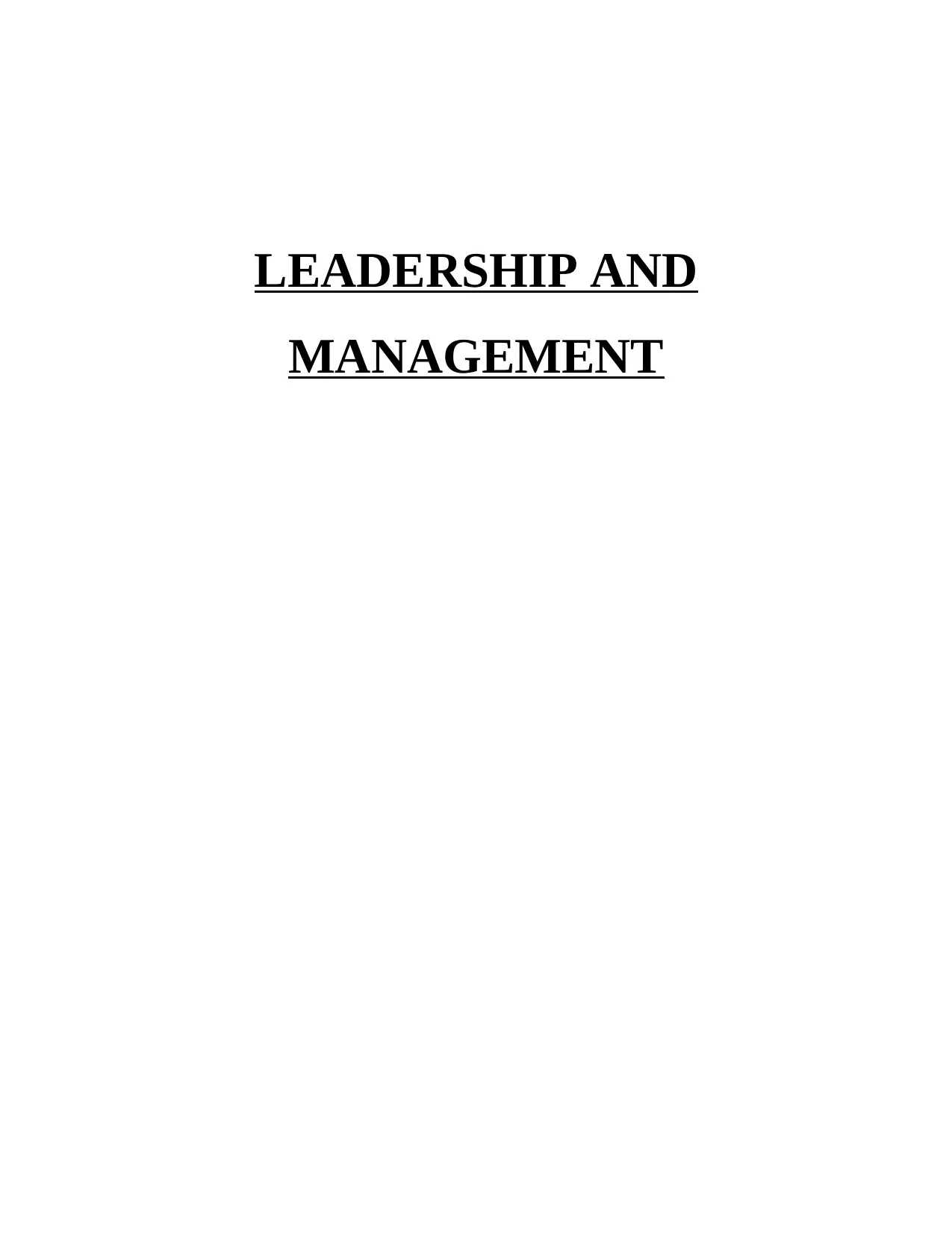
LEADERSHIP AND
MANAGEMENT
MANAGEMENT
Secure Best Marks with AI Grader
Need help grading? Try our AI Grader for instant feedback on your assignments.

Table of Contents
INTRODUCTION...........................................................................................................................3
PART 1............................................................................................................................................3
1- Conducting research into management & leadership theories and their application in
workplace.....................................................................................................................................3
2- Contrasting at least two other organizational examples to compare their varied styles of
leadership & management approaches in the context of different business situations................4
3- Examining different leadership and management methods to evaluate their effectiveness &
impact of both terms....................................................................................................................5
4- Analysing various leadership theory examples and their impact on decision-making &
effectiveness................................................................................................................................6
5- Comparing leadership and management activities in different companies.............................7
6- Importance of culture and role of leaders & managers...........................................................7
7- Critical reflection on impact of management and leadership..................................................7
PART 2............................................................................................................................................8
CONCLUSION................................................................................................................................8
REFERENCES................................................................................................................................9
INTRODUCTION...........................................................................................................................3
PART 1............................................................................................................................................3
1- Conducting research into management & leadership theories and their application in
workplace.....................................................................................................................................3
2- Contrasting at least two other organizational examples to compare their varied styles of
leadership & management approaches in the context of different business situations................4
3- Examining different leadership and management methods to evaluate their effectiveness &
impact of both terms....................................................................................................................5
4- Analysing various leadership theory examples and their impact on decision-making &
effectiveness................................................................................................................................6
5- Comparing leadership and management activities in different companies.............................7
6- Importance of culture and role of leaders & managers...........................................................7
7- Critical reflection on impact of management and leadership..................................................7
PART 2............................................................................................................................................8
CONCLUSION................................................................................................................................8
REFERENCES................................................................................................................................9
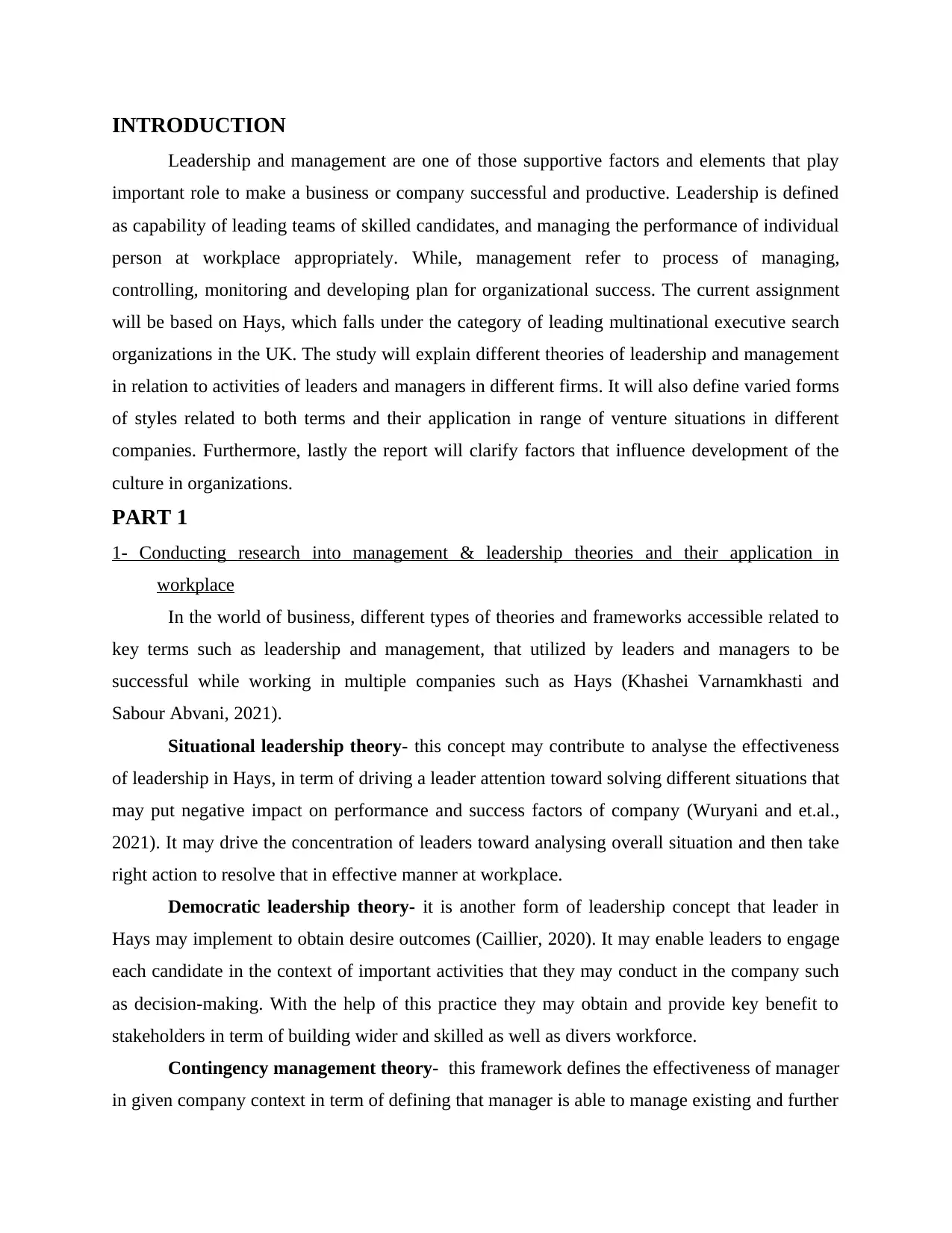
INTRODUCTION
Leadership and management are one of those supportive factors and elements that play
important role to make a business or company successful and productive. Leadership is defined
as capability of leading teams of skilled candidates, and managing the performance of individual
person at workplace appropriately. While, management refer to process of managing,
controlling, monitoring and developing plan for organizational success. The current assignment
will be based on Hays, which falls under the category of leading multinational executive search
organizations in the UK. The study will explain different theories of leadership and management
in relation to activities of leaders and managers in different firms. It will also define varied forms
of styles related to both terms and their application in range of venture situations in different
companies. Furthermore, lastly the report will clarify factors that influence development of the
culture in organizations.
PART 1
1- Conducting research into management & leadership theories and their application in
workplace
In the world of business, different types of theories and frameworks accessible related to
key terms such as leadership and management, that utilized by leaders and managers to be
successful while working in multiple companies such as Hays (Khashei Varnamkhasti and
Sabour Abvani, 2021).
Situational leadership theory- this concept may contribute to analyse the effectiveness
of leadership in Hays, in term of driving a leader attention toward solving different situations that
may put negative impact on performance and success factors of company (Wuryani and et.al.,
2021). It may drive the concentration of leaders toward analysing overall situation and then take
right action to resolve that in effective manner at workplace.
Democratic leadership theory- it is another form of leadership concept that leader in
Hays may implement to obtain desire outcomes (Caillier, 2020). It may enable leaders to engage
each candidate in the context of important activities that they may conduct in the company such
as decision-making. With the help of this practice they may obtain and provide key benefit to
stakeholders in term of building wider and skilled as well as divers workforce.
Contingency management theory- this framework defines the effectiveness of manager
in given company context in term of defining that manager is able to manage existing and further
Leadership and management are one of those supportive factors and elements that play
important role to make a business or company successful and productive. Leadership is defined
as capability of leading teams of skilled candidates, and managing the performance of individual
person at workplace appropriately. While, management refer to process of managing,
controlling, monitoring and developing plan for organizational success. The current assignment
will be based on Hays, which falls under the category of leading multinational executive search
organizations in the UK. The study will explain different theories of leadership and management
in relation to activities of leaders and managers in different firms. It will also define varied forms
of styles related to both terms and their application in range of venture situations in different
companies. Furthermore, lastly the report will clarify factors that influence development of the
culture in organizations.
PART 1
1- Conducting research into management & leadership theories and their application in
workplace
In the world of business, different types of theories and frameworks accessible related to
key terms such as leadership and management, that utilized by leaders and managers to be
successful while working in multiple companies such as Hays (Khashei Varnamkhasti and
Sabour Abvani, 2021).
Situational leadership theory- this concept may contribute to analyse the effectiveness
of leadership in Hays, in term of driving a leader attention toward solving different situations that
may put negative impact on performance and success factors of company (Wuryani and et.al.,
2021). It may drive the concentration of leaders toward analysing overall situation and then take
right action to resolve that in effective manner at workplace.
Democratic leadership theory- it is another form of leadership concept that leader in
Hays may implement to obtain desire outcomes (Caillier, 2020). It may enable leaders to engage
each candidate in the context of important activities that they may conduct in the company such
as decision-making. With the help of this practice they may obtain and provide key benefit to
stakeholders in term of building wider and skilled as well as divers workforce.
Contingency management theory- this framework defines the effectiveness of manager
in given company context in term of defining that manager is able to manage existing and further
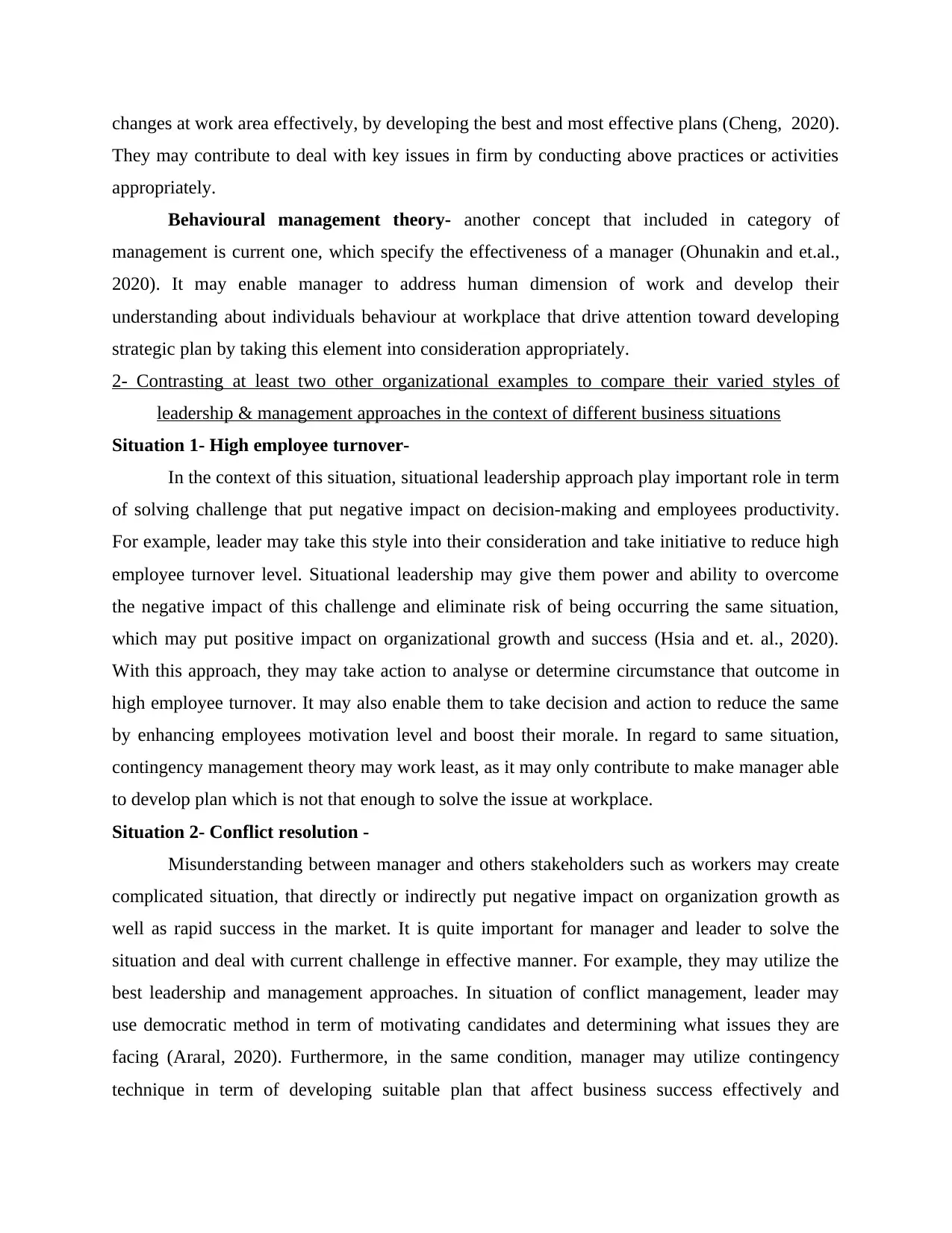
changes at work area effectively, by developing the best and most effective plans (Cheng, 2020).
They may contribute to deal with key issues in firm by conducting above practices or activities
appropriately.
Behavioural management theory- another concept that included in category of
management is current one, which specify the effectiveness of a manager (Ohunakin and et.al.,
2020). It may enable manager to address human dimension of work and develop their
understanding about individuals behaviour at workplace that drive attention toward developing
strategic plan by taking this element into consideration appropriately.
2- Contrasting at least two other organizational examples to compare their varied styles of
leadership & management approaches in the context of different business situations
Situation 1- High employee turnover-
In the context of this situation, situational leadership approach play important role in term
of solving challenge that put negative impact on decision-making and employees productivity.
For example, leader may take this style into their consideration and take initiative to reduce high
employee turnover level. Situational leadership may give them power and ability to overcome
the negative impact of this challenge and eliminate risk of being occurring the same situation,
which may put positive impact on organizational growth and success (Hsia and et. al., 2020).
With this approach, they may take action to analyse or determine circumstance that outcome in
high employee turnover. It may also enable them to take decision and action to reduce the same
by enhancing employees motivation level and boost their morale. In regard to same situation,
contingency management theory may work least, as it may only contribute to make manager able
to develop plan which is not that enough to solve the issue at workplace.
Situation 2- Conflict resolution -
Misunderstanding between manager and others stakeholders such as workers may create
complicated situation, that directly or indirectly put negative impact on organization growth as
well as rapid success in the market. It is quite important for manager and leader to solve the
situation and deal with current challenge in effective manner. For example, they may utilize the
best leadership and management approaches. In situation of conflict management, leader may
use democratic method in term of motivating candidates and determining what issues they are
facing (Araral, 2020). Furthermore, in the same condition, manager may utilize contingency
technique in term of developing suitable plan that affect business success effectively and
They may contribute to deal with key issues in firm by conducting above practices or activities
appropriately.
Behavioural management theory- another concept that included in category of
management is current one, which specify the effectiveness of a manager (Ohunakin and et.al.,
2020). It may enable manager to address human dimension of work and develop their
understanding about individuals behaviour at workplace that drive attention toward developing
strategic plan by taking this element into consideration appropriately.
2- Contrasting at least two other organizational examples to compare their varied styles of
leadership & management approaches in the context of different business situations
Situation 1- High employee turnover-
In the context of this situation, situational leadership approach play important role in term
of solving challenge that put negative impact on decision-making and employees productivity.
For example, leader may take this style into their consideration and take initiative to reduce high
employee turnover level. Situational leadership may give them power and ability to overcome
the negative impact of this challenge and eliminate risk of being occurring the same situation,
which may put positive impact on organizational growth and success (Hsia and et. al., 2020).
With this approach, they may take action to analyse or determine circumstance that outcome in
high employee turnover. It may also enable them to take decision and action to reduce the same
by enhancing employees motivation level and boost their morale. In regard to same situation,
contingency management theory may work least, as it may only contribute to make manager able
to develop plan which is not that enough to solve the issue at workplace.
Situation 2- Conflict resolution -
Misunderstanding between manager and others stakeholders such as workers may create
complicated situation, that directly or indirectly put negative impact on organization growth as
well as rapid success in the market. It is quite important for manager and leader to solve the
situation and deal with current challenge in effective manner. For example, they may utilize the
best leadership and management approaches. In situation of conflict management, leader may
use democratic method in term of motivating candidates and determining what issues they are
facing (Araral, 2020). Furthermore, in the same condition, manager may utilize contingency
technique in term of developing suitable plan that affect business success effectively and
Secure Best Marks with AI Grader
Need help grading? Try our AI Grader for instant feedback on your assignments.

successfully. It may make them capable to consider realistic view of overall situation and then
take action, which is essential and beneficial in varied terms.
3- Examining different leadership and management methods to evaluate their effectiveness &
impact of both terms.
Situational and democratic leadership approaches are utilized in the corporate world in
effective and systematic manner, for purpose of gaining competitive advantages in term of
building skilled workforce, among which each candidate is able to give tough competition to
other brands (Gottfredson and Reina, 2020). For example, situational leadership approach may
put positive impact on firm and employees in term of recognizing need for flexibility that
enhance candidates performance and motivate them to work with same firm like Hays.
Democratic method also support to make organization productive and competitive, in term of
engaging individual person in the context of decision-making process to share their perspectives.
With this practice, leader may gain benefit of increasing workforce and retaining talented
employees, among which each member is hard-working and able to make achievable
commitment regarding aim achievement of firm, which is quite essential for them to do so.
Contingency and behaviour management methods are effective as leadership because
these two concepts make manager highly efficient to deal with varied circumstances or overcome
the worst situations by developing the most effective and useful plan (Adaurhere, Musonda and
Okoro, 2021). For example, just because of contingency theory of management, manager may
become situation oriented person instead of stereotype. They may take initiative to understand
the behaviour or needs of employees at workplace before making any plan and taking action to
implement that in the Hays.
Leadership and management play important role on performance and culture of chosen
company in term of creating positive and productive work environments, where individual
candidate prefer to perform specific task and engage themselves to work in critical situation,
which may enable firm to grow rapidly. It may contribute to enhance staff motivation and boost
morale that drive their concentration to work better and in productive manner that may support to
make firm competitive.
take action, which is essential and beneficial in varied terms.
3- Examining different leadership and management methods to evaluate their effectiveness &
impact of both terms.
Situational and democratic leadership approaches are utilized in the corporate world in
effective and systematic manner, for purpose of gaining competitive advantages in term of
building skilled workforce, among which each candidate is able to give tough competition to
other brands (Gottfredson and Reina, 2020). For example, situational leadership approach may
put positive impact on firm and employees in term of recognizing need for flexibility that
enhance candidates performance and motivate them to work with same firm like Hays.
Democratic method also support to make organization productive and competitive, in term of
engaging individual person in the context of decision-making process to share their perspectives.
With this practice, leader may gain benefit of increasing workforce and retaining talented
employees, among which each member is hard-working and able to make achievable
commitment regarding aim achievement of firm, which is quite essential for them to do so.
Contingency and behaviour management methods are effective as leadership because
these two concepts make manager highly efficient to deal with varied circumstances or overcome
the worst situations by developing the most effective and useful plan (Adaurhere, Musonda and
Okoro, 2021). For example, just because of contingency theory of management, manager may
become situation oriented person instead of stereotype. They may take initiative to understand
the behaviour or needs of employees at workplace before making any plan and taking action to
implement that in the Hays.
Leadership and management play important role on performance and culture of chosen
company in term of creating positive and productive work environments, where individual
candidate prefer to perform specific task and engage themselves to work in critical situation,
which may enable firm to grow rapidly. It may contribute to enhance staff motivation and boost
morale that drive their concentration to work better and in productive manner that may support to
make firm competitive.
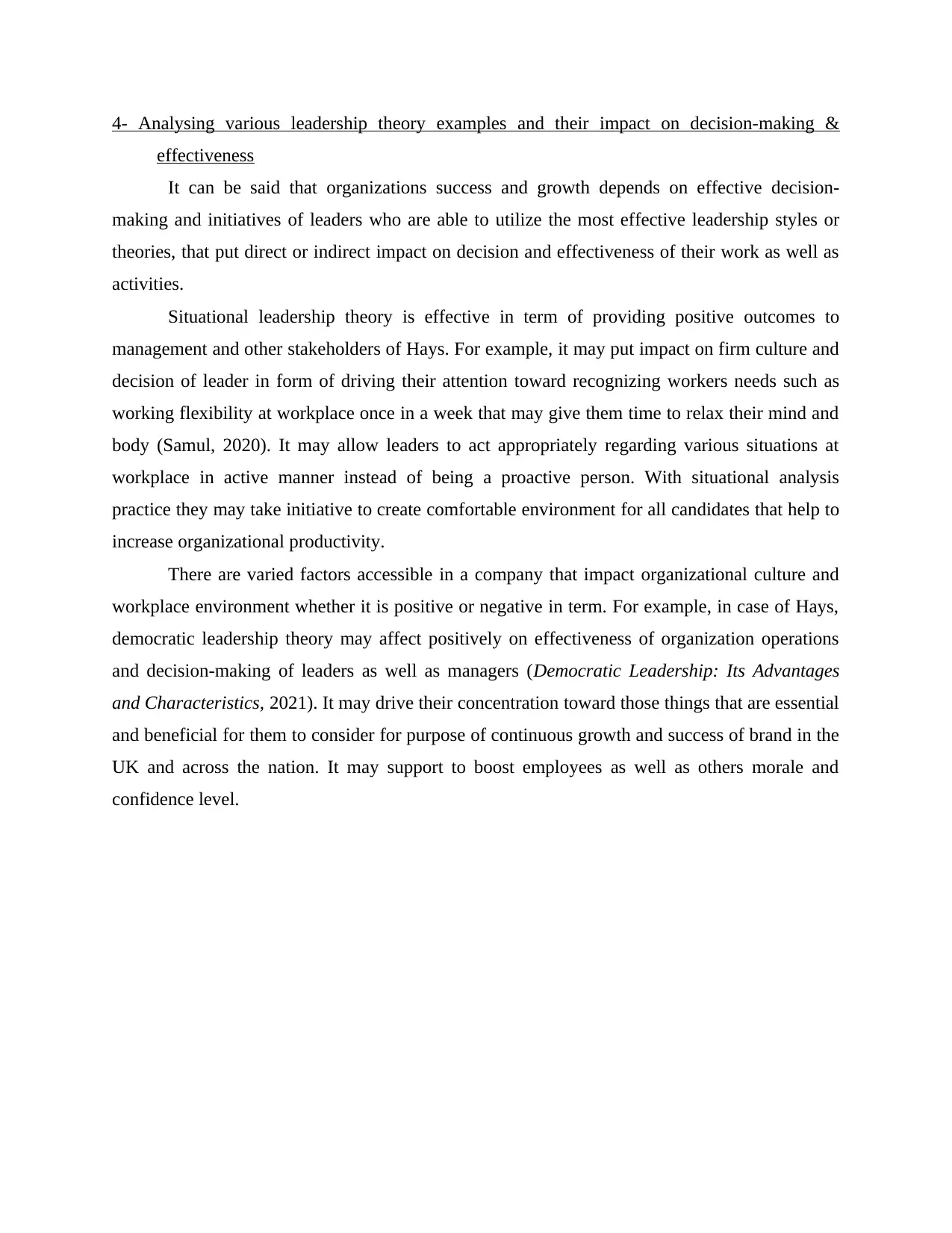
4- Analysing various leadership theory examples and their impact on decision-making &
effectiveness
It can be said that organizations success and growth depends on effective decision-
making and initiatives of leaders who are able to utilize the most effective leadership styles or
theories, that put direct or indirect impact on decision and effectiveness of their work as well as
activities.
Situational leadership theory is effective in term of providing positive outcomes to
management and other stakeholders of Hays. For example, it may put impact on firm culture and
decision of leader in form of driving their attention toward recognizing workers needs such as
working flexibility at workplace once in a week that may give them time to relax their mind and
body (Samul, 2020). It may allow leaders to act appropriately regarding various situations at
workplace in active manner instead of being a proactive person. With situational analysis
practice they may take initiative to create comfortable environment for all candidates that help to
increase organizational productivity.
There are varied factors accessible in a company that impact organizational culture and
workplace environment whether it is positive or negative in term. For example, in case of Hays,
democratic leadership theory may affect positively on effectiveness of organization operations
and decision-making of leaders as well as managers (Democratic Leadership: Its Advantages
and Characteristics, 2021). It may drive their concentration toward those things that are essential
and beneficial for them to consider for purpose of continuous growth and success of brand in the
UK and across the nation. It may support to boost employees as well as others morale and
confidence level.
effectiveness
It can be said that organizations success and growth depends on effective decision-
making and initiatives of leaders who are able to utilize the most effective leadership styles or
theories, that put direct or indirect impact on decision and effectiveness of their work as well as
activities.
Situational leadership theory is effective in term of providing positive outcomes to
management and other stakeholders of Hays. For example, it may put impact on firm culture and
decision of leader in form of driving their attention toward recognizing workers needs such as
working flexibility at workplace once in a week that may give them time to relax their mind and
body (Samul, 2020). It may allow leaders to act appropriately regarding various situations at
workplace in active manner instead of being a proactive person. With situational analysis
practice they may take initiative to create comfortable environment for all candidates that help to
increase organizational productivity.
There are varied factors accessible in a company that impact organizational culture and
workplace environment whether it is positive or negative in term. For example, in case of Hays,
democratic leadership theory may affect positively on effectiveness of organization operations
and decision-making of leaders as well as managers (Democratic Leadership: Its Advantages
and Characteristics, 2021). It may drive their concentration toward those things that are essential
and beneficial for them to consider for purpose of continuous growth and success of brand in the
UK and across the nation. It may support to boost employees as well as others morale and
confidence level.
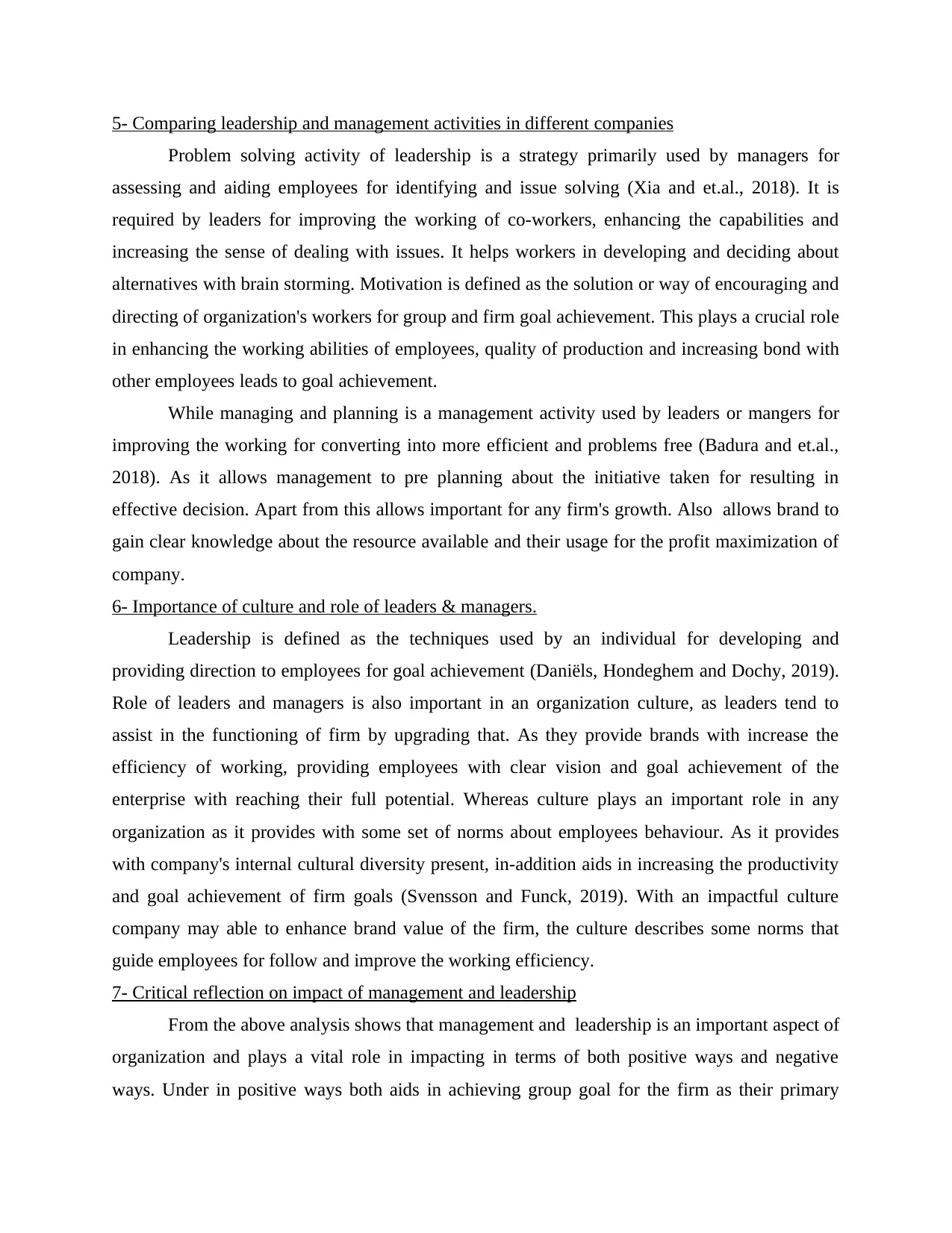
5- Comparing leadership and management activities in different companies
Problem solving activity of leadership is a strategy primarily used by managers for
assessing and aiding employees for identifying and issue solving (Xia and et.al., 2018). It is
required by leaders for improving the working of co-workers, enhancing the capabilities and
increasing the sense of dealing with issues. It helps workers in developing and deciding about
alternatives with brain storming. Motivation is defined as the solution or way of encouraging and
directing of organization's workers for group and firm goal achievement. This plays a crucial role
in enhancing the working abilities of employees, quality of production and increasing bond with
other employees leads to goal achievement.
While managing and planning is a management activity used by leaders or mangers for
improving the working for converting into more efficient and problems free (Badura and et.al.,
2018). As it allows management to pre planning about the initiative taken for resulting in
effective decision. Apart from this allows important for any firm's growth. Also allows brand to
gain clear knowledge about the resource available and their usage for the profit maximization of
company.
6- Importance of culture and role of leaders & managers.
Leadership is defined as the techniques used by an individual for developing and
providing direction to employees for goal achievement (Daniëls, Hondeghem and Dochy, 2019).
Role of leaders and managers is also important in an organization culture, as leaders tend to
assist in the functioning of firm by upgrading that. As they provide brands with increase the
efficiency of working, providing employees with clear vision and goal achievement of the
enterprise with reaching their full potential. Whereas culture plays an important role in any
organization as it provides with some set of norms about employees behaviour. As it provides
with company's internal cultural diversity present, in-addition aids in increasing the productivity
and goal achievement of firm goals (Svensson and Funck, 2019). With an impactful culture
company may able to enhance brand value of the firm, the culture describes some norms that
guide employees for follow and improve the working efficiency.
7- Critical reflection on impact of management and leadership
From the above analysis shows that management and leadership is an important aspect of
organization and plays a vital role in impacting in terms of both positive ways and negative
ways. Under in positive ways both aids in achieving group goal for the firm as their primary
Problem solving activity of leadership is a strategy primarily used by managers for
assessing and aiding employees for identifying and issue solving (Xia and et.al., 2018). It is
required by leaders for improving the working of co-workers, enhancing the capabilities and
increasing the sense of dealing with issues. It helps workers in developing and deciding about
alternatives with brain storming. Motivation is defined as the solution or way of encouraging and
directing of organization's workers for group and firm goal achievement. This plays a crucial role
in enhancing the working abilities of employees, quality of production and increasing bond with
other employees leads to goal achievement.
While managing and planning is a management activity used by leaders or mangers for
improving the working for converting into more efficient and problems free (Badura and et.al.,
2018). As it allows management to pre planning about the initiative taken for resulting in
effective decision. Apart from this allows important for any firm's growth. Also allows brand to
gain clear knowledge about the resource available and their usage for the profit maximization of
company.
6- Importance of culture and role of leaders & managers.
Leadership is defined as the techniques used by an individual for developing and
providing direction to employees for goal achievement (Daniëls, Hondeghem and Dochy, 2019).
Role of leaders and managers is also important in an organization culture, as leaders tend to
assist in the functioning of firm by upgrading that. As they provide brands with increase the
efficiency of working, providing employees with clear vision and goal achievement of the
enterprise with reaching their full potential. Whereas culture plays an important role in any
organization as it provides with some set of norms about employees behaviour. As it provides
with company's internal cultural diversity present, in-addition aids in increasing the productivity
and goal achievement of firm goals (Svensson and Funck, 2019). With an impactful culture
company may able to enhance brand value of the firm, the culture describes some norms that
guide employees for follow and improve the working efficiency.
7- Critical reflection on impact of management and leadership
From the above analysis shows that management and leadership is an important aspect of
organization and plays a vital role in impacting in terms of both positive ways and negative
ways. Under in positive ways both aids in achieving group goal for the firm as their primary
Paraphrase This Document
Need a fresh take? Get an instant paraphrase of this document with our AI Paraphraser
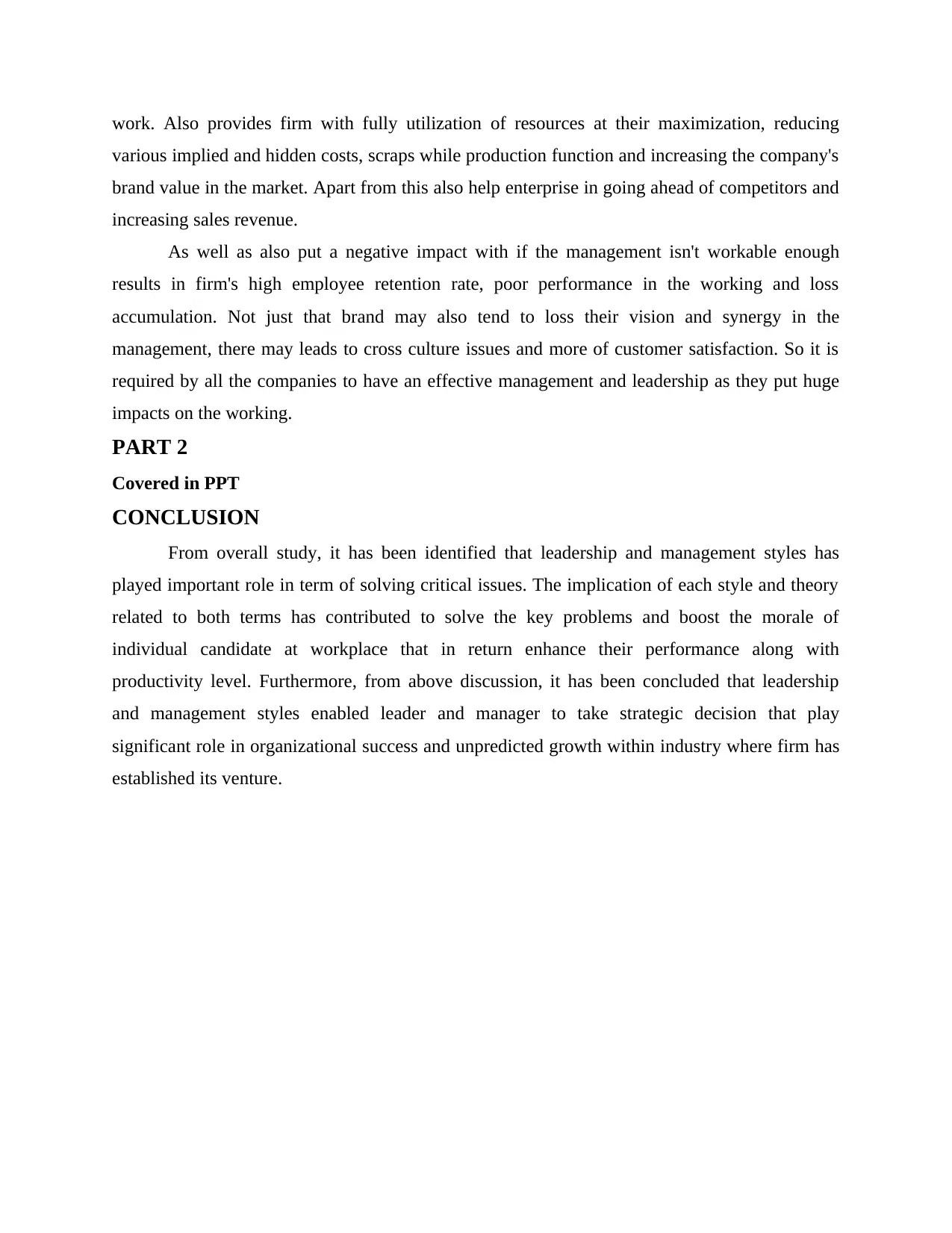
work. Also provides firm with fully utilization of resources at their maximization, reducing
various implied and hidden costs, scraps while production function and increasing the company's
brand value in the market. Apart from this also help enterprise in going ahead of competitors and
increasing sales revenue.
As well as also put a negative impact with if the management isn't workable enough
results in firm's high employee retention rate, poor performance in the working and loss
accumulation. Not just that brand may also tend to loss their vision and synergy in the
management, there may leads to cross culture issues and more of customer satisfaction. So it is
required by all the companies to have an effective management and leadership as they put huge
impacts on the working.
PART 2
Covered in PPT
CONCLUSION
From overall study, it has been identified that leadership and management styles has
played important role in term of solving critical issues. The implication of each style and theory
related to both terms has contributed to solve the key problems and boost the morale of
individual candidate at workplace that in return enhance their performance along with
productivity level. Furthermore, from above discussion, it has been concluded that leadership
and management styles enabled leader and manager to take strategic decision that play
significant role in organizational success and unpredicted growth within industry where firm has
established its venture.
various implied and hidden costs, scraps while production function and increasing the company's
brand value in the market. Apart from this also help enterprise in going ahead of competitors and
increasing sales revenue.
As well as also put a negative impact with if the management isn't workable enough
results in firm's high employee retention rate, poor performance in the working and loss
accumulation. Not just that brand may also tend to loss their vision and synergy in the
management, there may leads to cross culture issues and more of customer satisfaction. So it is
required by all the companies to have an effective management and leadership as they put huge
impacts on the working.
PART 2
Covered in PPT
CONCLUSION
From overall study, it has been identified that leadership and management styles has
played important role in term of solving critical issues. The implication of each style and theory
related to both terms has contributed to solve the key problems and boost the morale of
individual candidate at workplace that in return enhance their performance along with
productivity level. Furthermore, from above discussion, it has been concluded that leadership
and management styles enabled leader and manager to take strategic decision that play
significant role in organizational success and unpredicted growth within industry where firm has
established its venture.
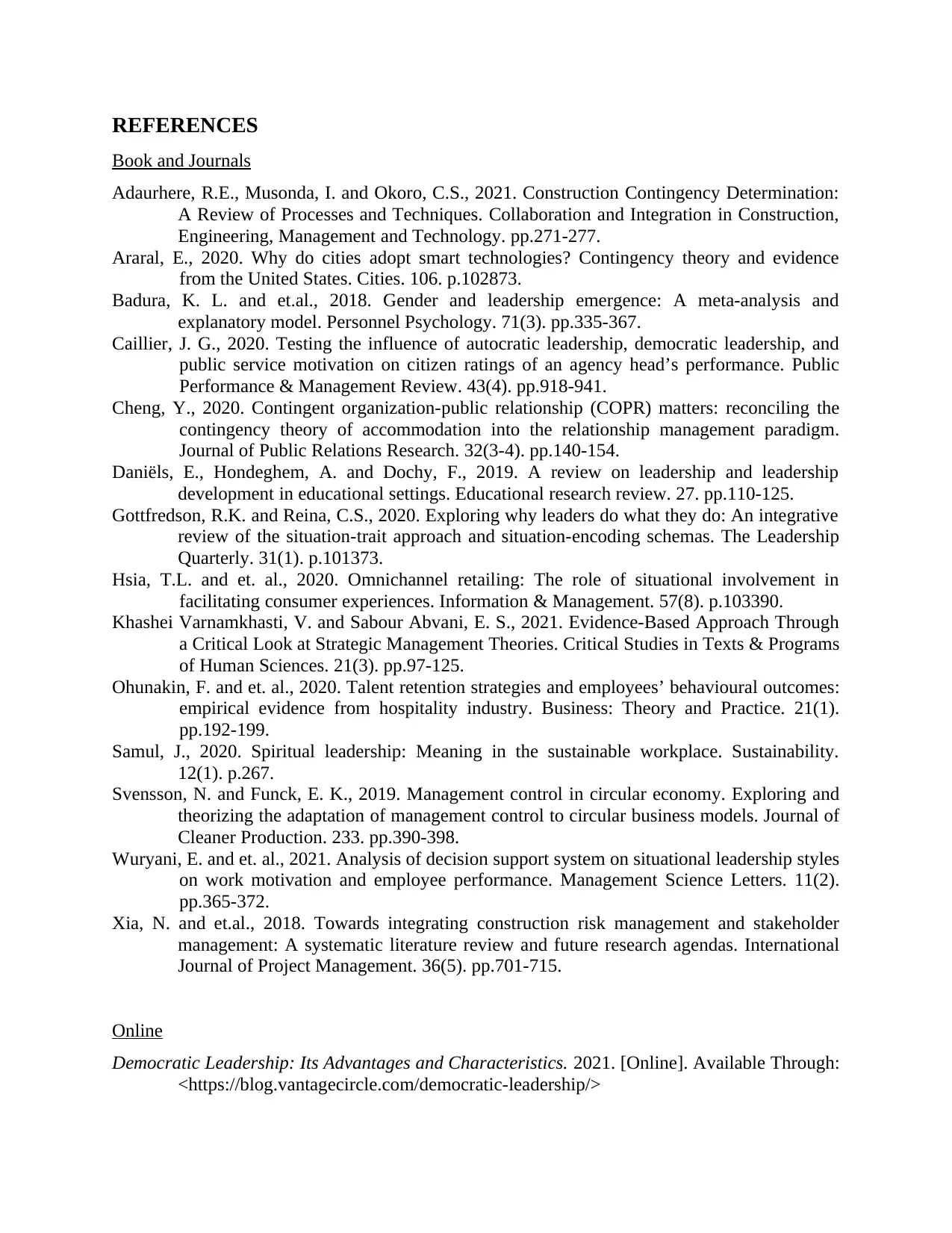
REFERENCES
Book and Journals
Adaurhere, R.E., Musonda, I. and Okoro, C.S., 2021. Construction Contingency Determination:
A Review of Processes and Techniques. Collaboration and Integration in Construction,
Engineering, Management and Technology. pp.271-277.
Araral, E., 2020. Why do cities adopt smart technologies? Contingency theory and evidence
from the United States. Cities. 106. p.102873.
Badura, K. L. and et.al., 2018. Gender and leadership emergence: A meta‐analysis and
explanatory model. Personnel Psychology. 71(3). pp.335-367.
Caillier, J. G., 2020. Testing the influence of autocratic leadership, democratic leadership, and
public service motivation on citizen ratings of an agency head’s performance. Public
Performance & Management Review. 43(4). pp.918-941.
Cheng, Y., 2020. Contingent organization-public relationship (COPR) matters: reconciling the
contingency theory of accommodation into the relationship management paradigm.
Journal of Public Relations Research. 32(3-4). pp.140-154.
Daniëls, E., Hondeghem, A. and Dochy, F., 2019. A review on leadership and leadership
development in educational settings. Educational research review. 27. pp.110-125.
Gottfredson, R.K. and Reina, C.S., 2020. Exploring why leaders do what they do: An integrative
review of the situation-trait approach and situation-encoding schemas. The Leadership
Quarterly. 31(1). p.101373.
Hsia, T.L. and et. al., 2020. Omnichannel retailing: The role of situational involvement in
facilitating consumer experiences. Information & Management. 57(8). p.103390.
Khashei Varnamkhasti, V. and Sabour Abvani, E. S., 2021. Evidence-Based Approach Through
a Critical Look at Strategic Management Theories. Critical Studies in Texts & Programs
of Human Sciences. 21(3). pp.97-125.
Ohunakin, F. and et. al., 2020. Talent retention strategies and employees’ behavioural outcomes:
empirical evidence from hospitality industry. Business: Theory and Practice. 21(1).
pp.192-199.
Samul, J., 2020. Spiritual leadership: Meaning in the sustainable workplace. Sustainability.
12(1). p.267.
Svensson, N. and Funck, E. K., 2019. Management control in circular economy. Exploring and
theorizing the adaptation of management control to circular business models. Journal of
Cleaner Production. 233. pp.390-398.
Wuryani, E. and et. al., 2021. Analysis of decision support system on situational leadership styles
on work motivation and employee performance. Management Science Letters. 11(2).
pp.365-372.
Xia, N. and et.al., 2018. Towards integrating construction risk management and stakeholder
management: A systematic literature review and future research agendas. International
Journal of Project Management. 36(5). pp.701-715.
Online
Democratic Leadership: Its Advantages and Characteristics. 2021. [Online]. Available Through:
<https://blog.vantagecircle.com/democratic-leadership/>
Book and Journals
Adaurhere, R.E., Musonda, I. and Okoro, C.S., 2021. Construction Contingency Determination:
A Review of Processes and Techniques. Collaboration and Integration in Construction,
Engineering, Management and Technology. pp.271-277.
Araral, E., 2020. Why do cities adopt smart technologies? Contingency theory and evidence
from the United States. Cities. 106. p.102873.
Badura, K. L. and et.al., 2018. Gender and leadership emergence: A meta‐analysis and
explanatory model. Personnel Psychology. 71(3). pp.335-367.
Caillier, J. G., 2020. Testing the influence of autocratic leadership, democratic leadership, and
public service motivation on citizen ratings of an agency head’s performance. Public
Performance & Management Review. 43(4). pp.918-941.
Cheng, Y., 2020. Contingent organization-public relationship (COPR) matters: reconciling the
contingency theory of accommodation into the relationship management paradigm.
Journal of Public Relations Research. 32(3-4). pp.140-154.
Daniëls, E., Hondeghem, A. and Dochy, F., 2019. A review on leadership and leadership
development in educational settings. Educational research review. 27. pp.110-125.
Gottfredson, R.K. and Reina, C.S., 2020. Exploring why leaders do what they do: An integrative
review of the situation-trait approach and situation-encoding schemas. The Leadership
Quarterly. 31(1). p.101373.
Hsia, T.L. and et. al., 2020. Omnichannel retailing: The role of situational involvement in
facilitating consumer experiences. Information & Management. 57(8). p.103390.
Khashei Varnamkhasti, V. and Sabour Abvani, E. S., 2021. Evidence-Based Approach Through
a Critical Look at Strategic Management Theories. Critical Studies in Texts & Programs
of Human Sciences. 21(3). pp.97-125.
Ohunakin, F. and et. al., 2020. Talent retention strategies and employees’ behavioural outcomes:
empirical evidence from hospitality industry. Business: Theory and Practice. 21(1).
pp.192-199.
Samul, J., 2020. Spiritual leadership: Meaning in the sustainable workplace. Sustainability.
12(1). p.267.
Svensson, N. and Funck, E. K., 2019. Management control in circular economy. Exploring and
theorizing the adaptation of management control to circular business models. Journal of
Cleaner Production. 233. pp.390-398.
Wuryani, E. and et. al., 2021. Analysis of decision support system on situational leadership styles
on work motivation and employee performance. Management Science Letters. 11(2).
pp.365-372.
Xia, N. and et.al., 2018. Towards integrating construction risk management and stakeholder
management: A systematic literature review and future research agendas. International
Journal of Project Management. 36(5). pp.701-715.
Online
Democratic Leadership: Its Advantages and Characteristics. 2021. [Online]. Available Through:
<https://blog.vantagecircle.com/democratic-leadership/>
1 out of 9
Related Documents
Your All-in-One AI-Powered Toolkit for Academic Success.
+13062052269
info@desklib.com
Available 24*7 on WhatsApp / Email
![[object Object]](/_next/static/media/star-bottom.7253800d.svg)
Unlock your academic potential
© 2024 | Zucol Services PVT LTD | All rights reserved.




